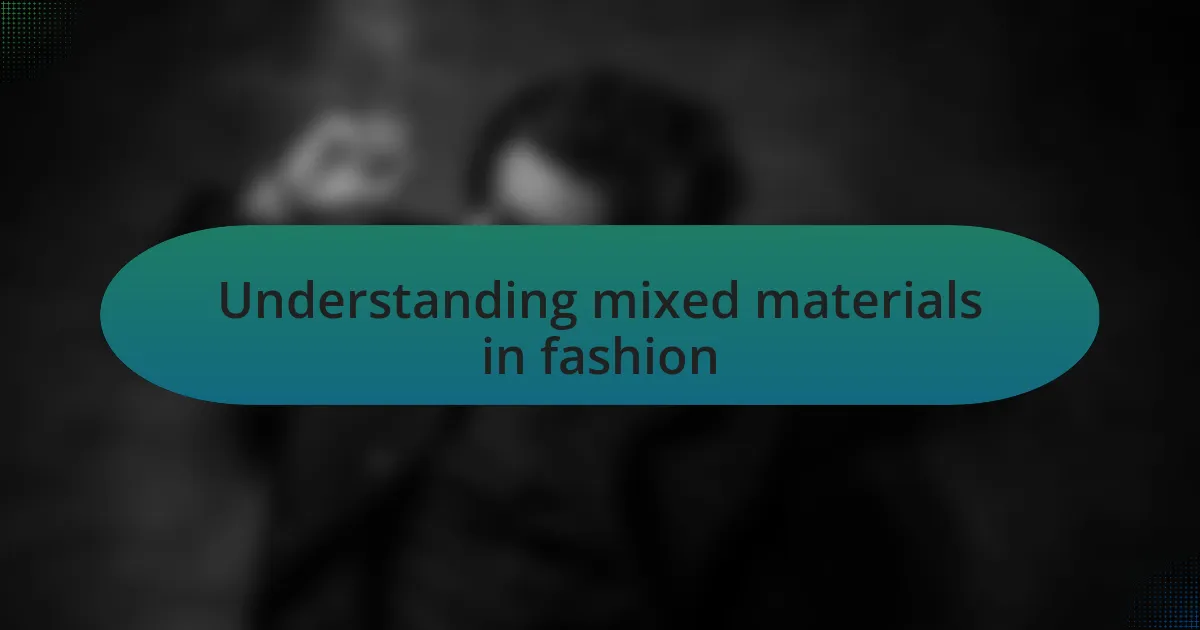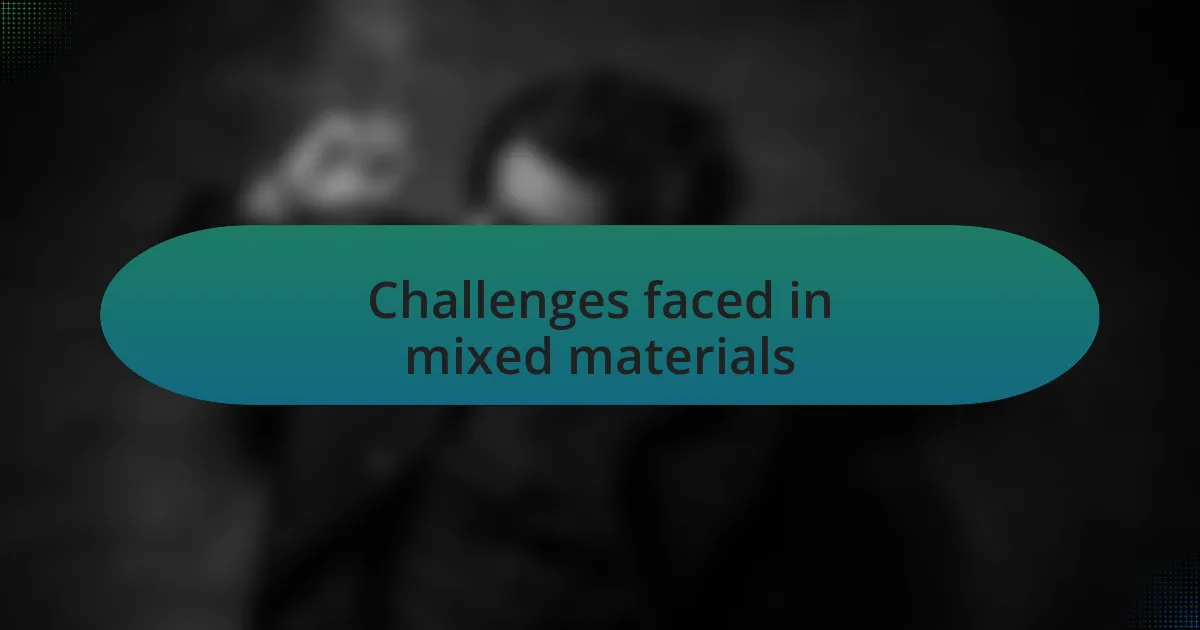Key takeaways:
- Mixing materials, such as combining structured and soft fabrics, creates dynamic silhouettes and enhances emotional expression in fashion.
- Challenges in working with mixed materials include balancing weight and durability while ensuring aesthetic harmony and color compatibility.
- Conducting fabric tests and understanding material properties are essential for successful design, preventing unexpected outcomes.
- Embracing experimentation can lead to innovative designs, encouraging creativity beyond traditional conventions.

Understanding mixed materials in fashion
Mixed materials in fashion represent a fascinating interplay of textures, shapes, and colors that can elevate a design from ordinary to extraordinary. I remember the first time I combined denim and silk in a project; the contrast created a vibrant energy that made the piece truly stand out. Isn’t it intriguing how the choice of fabric can completely change the vibe of a garment?
Understanding the properties of different materials is crucial in this process. For instance, pairing a structured fabric with a soft one can create a dynamic silhouette that captures attention. Have you ever worn a dress that just flowed beautifully with every movement? That magic often comes from the thoughtful combination of materials that complement each other.
As I experimented with mixed materials, I discovered that each combination tells its own story, layered with emotional significance and personal expression. The way a leather jacket feels against a delicate lace top can evoke a sense of boldness intertwined with femininity. Have you found yourself drawn to a particular mix of textures that resonate with your personal style? It’s these unique encounters with material that truly shape our fashion journeys.

My experiences with mixed materials
My experiences with mixed materials have often felt like a delightful puzzle, each piece revealing new possibilities. I vividly recall a project where I used canvas alongside chiffon. The juxtaposition between the sturdy, utilitarian nature of the canvas and the ethereal lightness of chiffon created an unexpected harmony that resonated deeply with me. Can you imagine how a simple styling choice can evoke such contrasting feelings?
I also encountered challenges while working with mixed materials; sometimes the fabrics just didn’t play nicely together. There was a particular instance with a wool-silk blend. I had envisioned a stunning coat, but the textures clashed during the construction phase. This taught me the importance of testing fabric compatibility. Have you ever faced the frustration of a vision not aligning with reality? Those moments have shaped my understanding and respect for the diverse nature of materials.
Every time I mix materials, there’s a rekindled thrill, as if I’m revisiting an old friend. I once created an outfit that featured both velvet and mesh; the plush richness of the velvet complemented the daring transparency of the mesh beautifully. Each time I wore that outfit, I felt empowered, a perfect emblem of duality—a blend of comfort and daring elegance. Have you ever experienced that empowering feeling just from an outfit? That’s the essence of what mixed materials offer; they tell our stories more than we realize.

Challenges faced in mixed materials
When working with mixed materials, one of the significant challenges I’ve faced is achieving the right balance in weight and drape. I once attempted to pair a heavy denim with a delicate lace, hoping their contrasting textures would create visual intrigue. Unfortunately, the lace lost its shape under the weight, completely altering the design’s intended effect. Have you ever realized that sometimes, despite your best intentions, the materials dictate the final outcome?
Another hurdle is ensuring durability without compromising aesthetics. I remember designing a bag that combined leather and sheer organza. While the organza provided a lovely visual appeal, it proved vulnerable to wear and tear, leaving me questioning the practicality of my creative choices. It made me wonder, how can we celebrate beauty while still being mindful of function in our designs?
Then there’s the challenge of color harmony. I’ve experimented with vibrant hues when mixing fabrics, but there have been instances when the colors emotionally clashed rather than complemented each other. I recall a project where I paired a bright orange with a muted taupe, thinking the contrast would pop. Instead, it felt jarring, a lesson learned about the emotional weight colors can carry together. Have you ever found yourself at a crossroads between aesthetic ambition and color reality? It’s a balancing act that keeps evolving.

Tips for mastering mixed materials
One effective tip for mastering mixed materials is to conduct fabric tests before committing to a design. I remember a time when I paired a structured canvas with a flowing chiffon for a summer dress. To my surprise, the chiffon ended up overpowering the canvas, losing the intended silhouette. By taking the time to sample the materials together through swatches or mini prototypes, you can gain insight into how they interact, preventing those unexpected surprises down the line. Have you ever wished you could see the future of your materials in advance?
Another crucial aspect is understanding the properties of each material you work with. For example, I once mixed a thick wool with satin for a winter coat. Initially, the combination seemed like a cozy idea, but the wool’s bulkiness challenged the satin’s smoothness, leading to a mismatch in comfort and style. By thoroughly learning about the flexibility, stretch, and fall of your chosen materials, you can make informed decisions that promote synergy rather than conflict. Isn’t it fascinating how much the material itself can influence a design’s narrative?
Lastly, embrace experimentation and don’t shy away from the unexpected. I vividly recall a project where I decided to incorporate recycled denim scraps into a more traditional fabric blend. Initially, I was apprehensive about how it would be received, but the result was a unique textural landscape that added depth and storytelling to the design. This experience taught me that limitations can spark creativity, pushing us to explore outside our comfort zones. Have you considered how breaking conventions might lead to your most innovative designs yet?